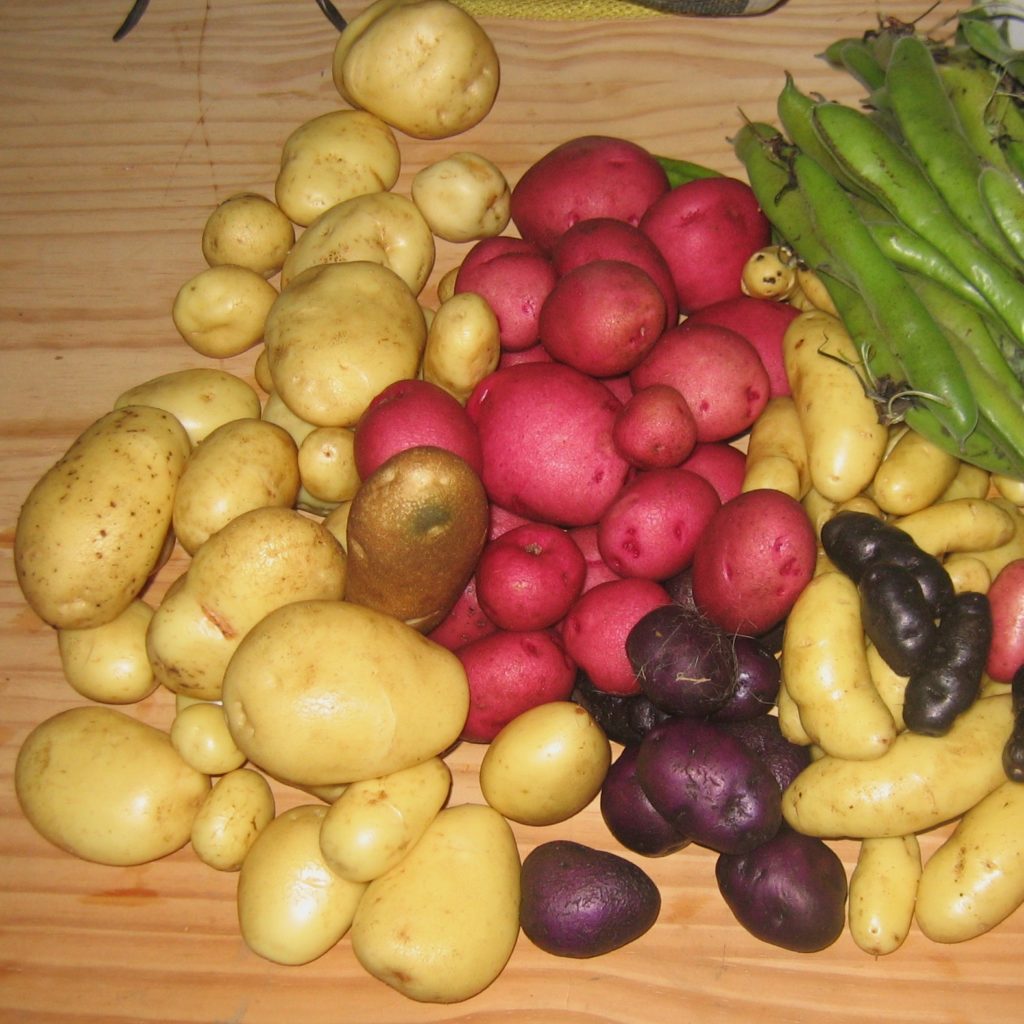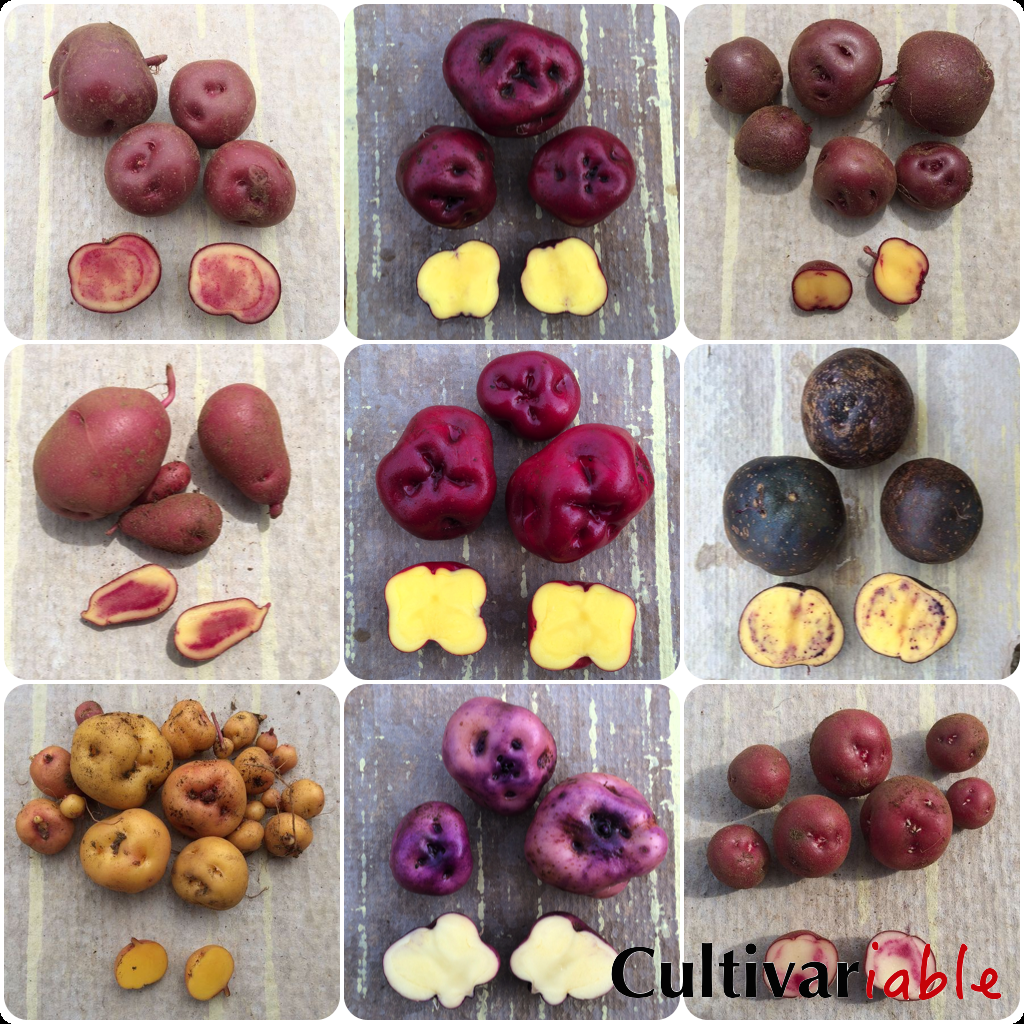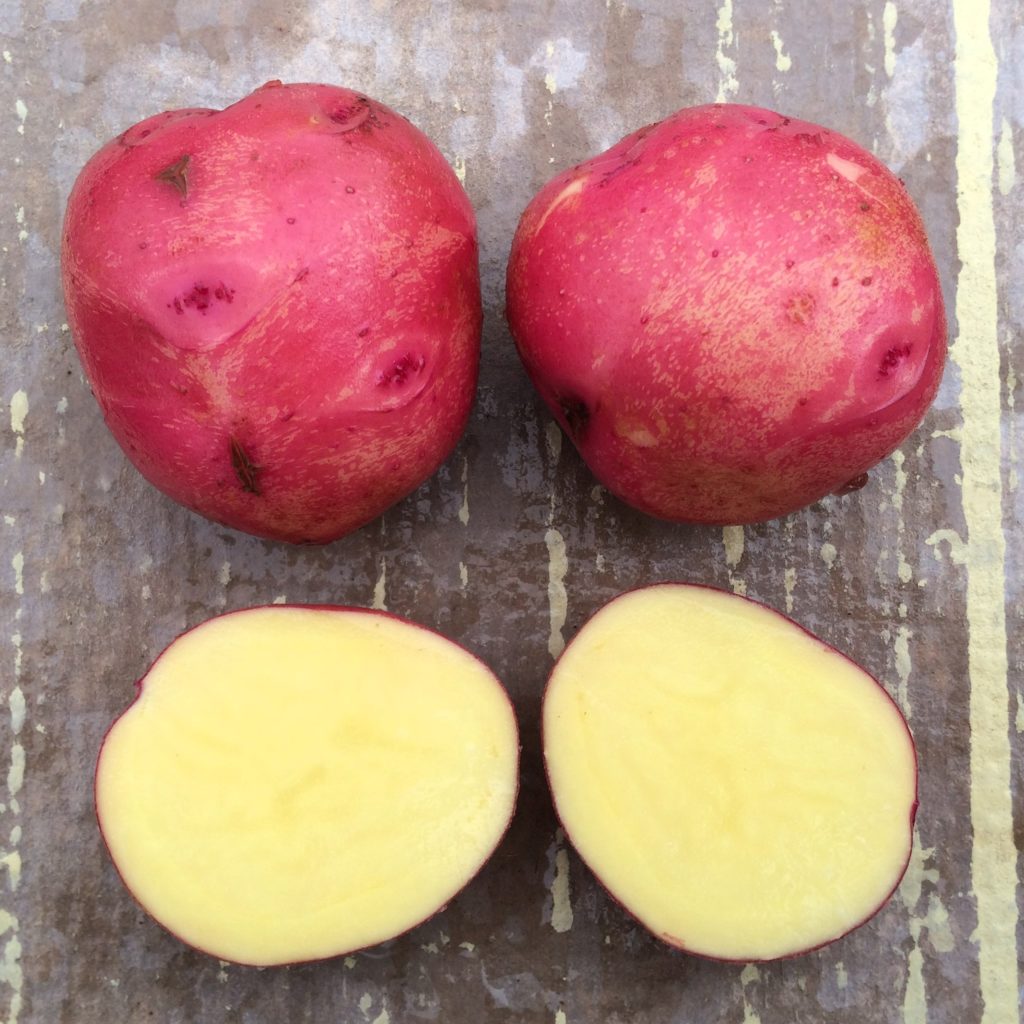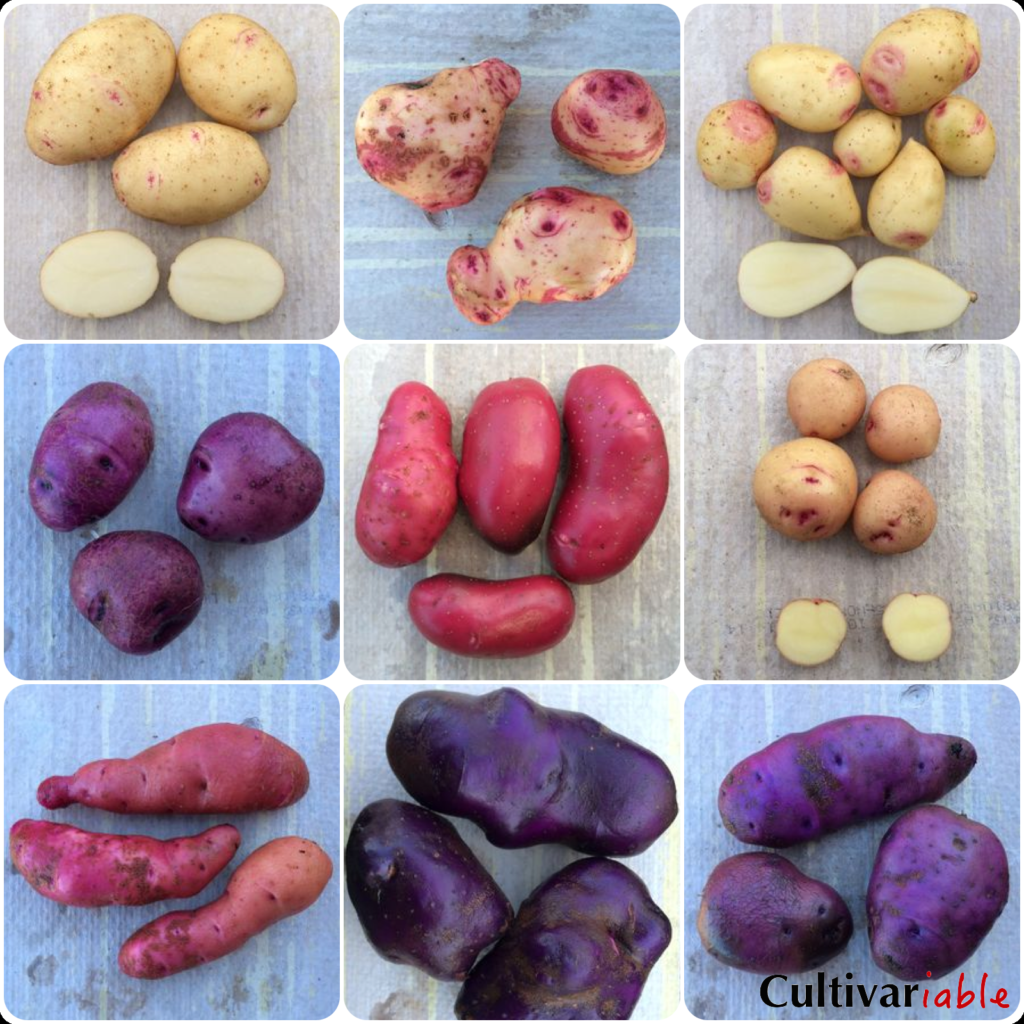Blog, breeding, potato (Solanum tuberosum)
About My Potato Breeding Projects
Because we sell excess seed from my potato breeding projects, we get a lot of questions about what my goals are. Those goals are sometimes hard to articulate because I haven’t thought through them as clearly as I have done for the other plants that I work with. My work with potatoes goes back before I ever thought about approaching this as a profession.
Some History
When I started my adventure in plant breeding, back in 2005, I initially chose the Jerusalem artichoke as my main interest. This was a great choice for learning about plant breeding and a poor choice for actually producing new varieties. There is a lot of complexity to Jerusalem artichoke breeding and ten years ago it was fairly difficult to obtain the diversity necessary to make much progress. Because potato is also a clonally propagated, polyploid tuber crop, researching Jerusalem artichokes frequently led me to related potato research and I started to become interested in potatoes, particularly due to the huge body of research available. There are something like 300 papers published about the potato for every one about Jerusalem artichoke. Before long, I left my Jerusalem artichoke patch to go feral and turned my attention almost entirely to potatoes. (Never fear; I eventually returned to Jerusalem artichoke breeding, but that is another story.)

Potatoes will always be a special plant for me because I learned most of what I know about plant breeding from working with potatoes. When I pollinated my first potato flowers and got my first seeds, I was still a blank slate. I knew very little about growing potatoes, much less breeding them, and my knowledge of plant breeding in general was rudimentary. Obtaining my first true potato seeds for breeding was a challenge because so little information was available. Because of that, I had a wide range of learning experiences with potatoes that I will never experience with other plants. When I approach a new plant now, I have some idea of what I want and also how to go about it. With potatoes, I not only didn’t know what I wanted, I didn’t know what was possible, and I certainly didn’t know how to achieve any particular outcome.
Because I knew so little, I was not deterred from taking any course of action and I tried just about everything. I obtained most of the commercial varieties that were available and tried to cross them, failing a large portion of the time. Failure is a good teacher and I learned quickly. Most of my early work took place in isolation, but I eventually met a few other hobbyists working with potatoes, some of whom had access to the USDA and CIP gene banks, which opened up a lot of new possibilities. Not long after that, I learned about Tom Wagner of Tater Mater Seeds, who periodically offered a large number of true potato seed varieties from his projects.
One of the things that I learned by exchanging material with other hobbyists was that my selections weren’t that great. I was certainly happy with them; they grew well for me and I liked to eat them, but they didn’t necessarily perform well for others in different climates and they weren’t that exciting in form or flavor. That was a valuable revelation, as it encouraged me to think more sparingly about breeding goals. One of the conclusions that I came to very quickly is that I can’t compete with the mainstream potato breeders and their broad criteria; that is, breeding simultaneously for size, yield, uniformity, disease resistance, even maturity, processing traits, storage life and quality, etc. The people who breed for the commodity market raise hundreds of thousands of seedlings to select one new variety. I can’t do that. The potatoes that I hold up as my best achievements are the sorts of potatoes that they discard by the thousands. The largest number of potato seedlings that I have ever grown in a year is about 10,000 and that was in the service of a dozen different breeding projects. I realized that I need to focus more narrowly.
Specialization
Mass market potatoes are pretty remarkable when you really think about it. They produce reliable yields under wide ranging soil and climate conditions. They resist the majority of common potato pests and diseases. They produce consistent harvest of uniform tubers and all mature at the same time. Most of them aren’t very exciting, but commodity crops aren’t meant to be. A farmer growing a commodity crop doesn’t want excitement, nor diversity. They want predictability and factory-like output of agricultural cogs. My initial potato varieties looked like those agricultural cogs, but weren’t as good. They looked like that because I started with mass market varieties. In 2007, I received some seeds derived from Andean potato varieties from a collector and started to realize that there is a whole world of potatoes that look and taste nothing like mass market types. I knew that was where I wanted to focus. Learning about the incredible potato diversity in the Andes led me almost immediately to information about the other Andean tuber crops and that was how I hit the critical mass that inspired Cultivariable, but that is yet another story.

I abandoned most of my earlier breeding projects and worked with my seedling varieties of Andean origin and held on to a few of the other more interesting varieties that were available in the US at the time, like Purple Peruvian, Ozette, French Fingerling, All Blue, and Pink Fir Apple. Only a couple of these varieties produced any seed. It turns out that most of the more colorful and fingerling type potatoes in the US are male sterile or almost totally sterile. (I have since obtained seed from all of the varieties named but, with the exception of All Blue, they are all pretty hard to work with and I don’t recommend starting with them.)
It took me a while to identify the sorts of potatoes that I was most interested in breeding. In fact, this process is ongoing. Diversity of potatoes is vast and although I have seen a lot more of what exists than most people, I am still discovering new kinds of potatoes every year. I am interested primarily in Andean potatoes, those currently classified as Solanum tuberosum ssp. andigenum, which includes both diploids and tetraploids. I am generally more interested in tetraploids than diploids, primarily due to problems with dormancy in many diploids. I am also interested in identifying superior diploid potatoes and trying to breed them for improved dormancy. I am very interested in crossing the unusual forms and flavors of diploid potatoes into tetraploids and in working with crosses between domesticated wild potatoes. If I could boil all of that down into one theme, it would be introducing forms and flavors from Andean potatoes into varieties that can be grown a little more easily in North America.
Priorities
As I have already mentioned, it is not really possible for a small breeder to compete at the mass market level. There are simply too many criteria that take too much time to evaluate for an individual to have much chance of discovering the next big commercial potato. That’s okay though, because I find those mass market potatoes rather dull these days. I’m looking for potatoes that home and small market growers will find exciting (and, even more importantly, that I find exciting). I can’t afford to take a decade to release a variety, so I have to prioritize the kind of evaluation that I can do parsimoniously.
The most important goal is to find potatoes that are well adapted for the Pacific Northwest. That’s where we are and where most of my customers live. Our climate has a long season of about 9-10 months, rarely experiences temperatures above 75 degrees F, has a summer drought, but very high rainfall the rest of the year, and usually experiences only mild frosts. So, potatoes grown from our seed will probably produce well if you have a similar climate. That said, most potato seed produces very diverse results, so you’re bound to find something that will suit your climate even if it is quite different; you just might have to go through more seedlings to find it.
Other than climate suitability, I mostly select based on the following criteria in order of precedence. I should note that I reverse engineered this list by looking at what traits I have selected in the past. This was not a plan. I mostly select varieties intuitively and these are the criteria that can be extracted from that intuitive process. It is rare that I keep a variety because it satisfies a particular metric. I keep varieties because something about them makes me happy. If I take a step back and examine what makes me happy, it is different varieties with a wide range of flavors, textures, shapes, and colors. I don’t want one great potato; I want lots of good potatoes. And I am always, more than anything, looking for interesting traits that I haven’t seen before.
- Flavor
- Interesting appearance
- Small to medium size
- Disease resistance
- Environmental tolerance
- Flowering/berrying
- Photoperiod
- Male fertility
- Yield
- Storage life
- Maturity
In general, if a variety excels in any category, I am willing to disregard all the criteria below it. For example, if a potato tastes fantastic but is boring looking, vulnerable to disease, yields poorly, stores poorly, and is early, I will probably still keep it for at least a few years in the hope of crossing it with varieties that can improve the remaining traits.

Flavor
You have undoubtedly noted that many of these criteria are subjective. What I like in potato flavor may be unappealing to you and what I consider to be an interesting appearance may look like a bloated grub to you. It is really hard to get specific with these traits, but I like my potatoes to have fairly strong flavor. The kind of flavor profile will vary with flesh density and color. For example, I like yellow potatoes to have a fairly strong carroty flavor. I like blue and white potatoes to have some bitter elements. I don’t favor the sort of bland, starchy potatoes that are so common in grocery stores. I also don’t prepare potatoes in too many ways: I mostly roast them in the skins or mash them, so I am only testing the flavor in those circumstances. I never make chips and rarely fry or make a big baked potato, so I am probably not selecting varieties that are at their best when cooked in those ways.
Appearance
When it comes to appearance, I prefer potatoes that have colored flesh first of all. If I can also get that with multi-colored skin and an unusual form, like a fingerling or something with deep eyes, so much the better. I like to grow potatoes that don’t look like something I can buy at the grocery store. This can be a particular challenge. Potatoes with yellow flesh usually taste great, but it is hard to get the deep yellow flesh that is present in some diploid varieties in more easily storable tetraploids. Potatoes with blue flesh often have poor flavor and potatoes with red flesh can be difficult to produce because blue flesh is genetically dominant over red. Round types are dominant over “primitive” long or curved tubers and deep eyes.
Size
Most Americans seem to like big potatoes. Grocery stores are full of long russets and big, round boiling potatoes. I’m not sure why this is. A lot of the flavor in a potato is in and just under the skin. The smaller the potatoes, the closer the ratio of skin to flesh. This intensifies flavor. It also improves nutrition, because most of the protein in potatoes in found in the same region. So, I like potatoes that range from about two to three inches in diameter best.
Disease and resistance
I’m lucky not to have a lot of potato diseases at our plot. We don’t live in farm country and I keep varieties that I receive as tubers isolated, so only our originally seed grown varieties are grown together. Still, we see some late blight, mostly late in the year, some potato leafroll virus, and we still have pesky potato virus Y, which is so hard to eradicate that it sometimes seems to arise from spontaneous generation. We also see the full range of bacterial problems, such as stem rots and scab. Because I don’t do any controlled resistance testing, I can’t really say how resistant our varieties are, but none of these diseases cause us serious problems. When a variety proves particularly vulnerable, I just discard it.
Environmental tolerance
This is probably more than one category, but it would be hard for me to break it out in a meaningful way. I provide plants very little fertilizer – just an annual topdressing with some composted manure and seaweed. I don’t use herbicides or pesticides. I have more weeding than I can keep up with. Sometimes pests get the upper hand for a while. Plants have to be able to survive these challenges. If they don’t produce well under a low input system, they won’t get selected.
Flowering/Berrying
If you want to keep breeding potatoes, you need to keep getting seed, so these traits are important. I rarely keep any variety that does not flower at all. If a variety doesn’t produce some berries without my help, I usually don’t keep it for long. This is usually not a difficult selection, because most of my plants are loaded with berries at this point. I also rarely keep very early varieties because early varieties often don’t flower.
Photoperiod
I work mostly with Andean potatoes and many of them are short day tuberizers, meaning that they don’t begin to form tubers until after the day length drops to about 12 hours in late September. I am lucky to live in a climate where there is time for short day varieties to develop. That makes breeding these varieties possible, but short day photoperiod is not really ideal. Earlier harvest is more convenient here and is a necessity in area with earlier freezes. So, while I don’t necessarily exclude short day varieties, I do my best to cross them to day neutral varieties to moderate that trait.
Male fertility
The majority of commercial cultivars are male sterile. This is not necessarily a bad trait, as it makes crosses easier, but it also limits the kinds of crosses that one can make. I don’t entirely exclude male sterile varieties, but I mostly do. A potato has to be pretty special before I will forgive its fertility problems.
Yield
There is obviously a lower limit below which it really isn’t worth the time to grow a variety, but otherwise I don’t really care about yield. I’m certainly excited if a variety with great flavor and appearance also has good yield, but I am almost as excited even if it has poor yield. This is one area where I definitely part ways with most farmers. I don’t sell potatoes by weight. I’d rather have less of a delicious potato than more of an average potato. I guess my lower limit is about half a pound. I grow a lot of varieties, so others will bring up the average.
Storage life
I don’t like to put potatoes on life support. We have a walk in cooler and I would prefer to put potatoes in there and forget about them until the next planting. This can be a challenge with earlies and particularly with low dormancy diploid varieties. They usually get deselected from my breeding program because they die before I get around to planting them. For special potatoes, I will make the effort, but even they are likely to eventually become the victims of neglect.
I also like to select potatoes that can survive the winter in the ground here. This simplifies storage a lot. The key trait for in ground storage here is not cold tolerance, because the soil almost never freezes more than an inch or two. Instead, the key trait is a tolerance for wet soil. The soil is saturated here usually from mid November to early April. This is really hard on potatoes, but some are able to come through in good condition.
Maturity
This is the last trait on the list because I mostly don’t care. Traits that matter to large monocrop farmers like a closed canopy and uniform senescence mean little to me. I’m happy to harvest plants as they die back. I have a slight preference for late, indeterminate varieties because they store better simply as a consequence of being harvested later, but if a potato can survive until the next growing season in our cooler, I don’t care if it is early, mid season, or late.
There are a lot more traits that don’t appear on the list and that means that I don’t really care. Professional breeders who want to produce new varieties for commerce have to think about tons of things that the small grower will never care about, such as resistance to handling damage, specific traits for chipping and frying, uniform size and shape, etc. It’s liberating not having to live up to those standards. My potatoes are much more satisfying in their unruliness and yours probably will be too.
Our true potato seeds are the progeny of varieties selected based on these criteria. Of course, my selections are only the most recent in generations of selections made to suit the values of different growers, going all the way back to the domestication of the potato. All of those values are still embedded in the genome, like one mosaic tiled over another. You might have to do a bit of chipping away to find the potato that you’re looking for, but it is probably not too far below the surface.


Hi-
This is not apropos, but I’m wondering if you have ever tried or (hope, hope!) might know of a seed source for hanchote, Cocinnia abyssinica. I’ve gotten seeds from you before and really appreciate your dedication to dissemination of the obscure!
Thanks,
E.